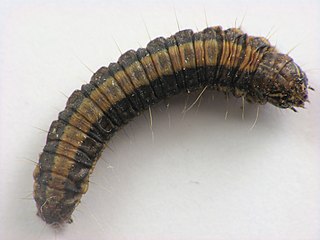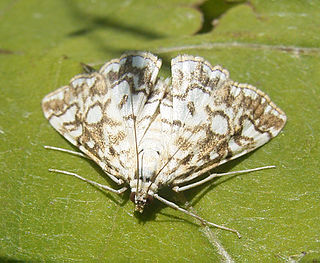Related Research Articles

Pyraustinae is a large subfamily of the lepidopteran family Crambidae, the crambid snout moths. It currently includes over 1,400 species; most of them tropical but some found in temperate regions including both North America and Europe.

Spilomelinae is a very species-rich subfamily of the lepidopteran family Crambidae, the crambid snout moths. With 4,132 described species in 340 genera worldwide, it is the most speciose group among pyraloids.

Caprinia is a genus of moths of the family Crambidae.

Diathrausta is a genus of moths of the family Crambidae. The genus was described by Julius Lederer in 1863.
Gonocausta is a genus of moths of the family Crambidae. The genus was first described by Julius Lederer in 1863.

Pycnarmon is a genus of moths of the family Crambidae described by Julius Lederer in 1863.

Pantographa is a genus of moths of the family Crambidae described by Julius Lederer in 1863.
Piletocera is a genus of moths of the family Crambidae. The genus was first described by Julius Lederer in 1863.

Pilocrocis is a genus of moths of the family Crambidae. The genus was first erected by Julius Lederer in 1863.

Glaphyria fulminalis, the black-patched glaphyria, is a species of moth of the family Crambidae described by Julius Lederer in 1863. It is found in the eastern part of the United States, from Connecticut to Florida, west to Texas and Illinois.

Parotis suralis is a moth of the family Crambidae. The species was first described by Julius Lederer in 1863. It is found around the west Pacific Rim, including the Chagos Islands, Hong Kong, Japan, Kiribati, Tuvalu and the tropical far north of Queensland.

The Epipaschiinae are a subfamily of snout moths. More than 720 species are known today, which are found mainly in the tropics and subtropics. Some occur in temperate regions, but the subfamily is apparently completely absent from Europe, at least as native species. A few Epipaschiinae are crop pests that may occasionally become economically significant.

Acentropinae is a fairly small subfamily of the lepidopteran family Crambidae, the crambid snout moths. Species of this subfamily are exclusively found in wetlands and aquatic habitats.

Odontiinae is a subfamily of moths of the family Crambidae. The subfamily was described by Achille Guenée in 1854.
Glyphodes doleschalii is a moth of the family Crambidae described by Julius Lederer in 1863. It is found in Queensland in northern Australia.

Glaphyriinae is a subfamily of the lepidopteran family Crambidae. It was described by William Trowbridge Merrifield Forbes in 1923. The subfamily currently comprises 509 species in 75 genera.

Cydalima pfeifferae is a moth in the family Crambidae. It was described by Julius Lederer in 1863. It is found in India, Myanmar, Singapore, Indonesia, Taiwan and Australia, where it has been recorded on Queensland.
Agroterini is a tribe of the species-rich subfamily Spilomelinae in the pyraloid moth family Crambidae. The tribe was erected by Alexandre Noël Charles Acloque in 1897.

Margaroniini is a tribe of the species-rich subfamily Spilomelinae in the pyraloid moth family Crambidae. The tribe was erected by Charles Swinhoe and Everard Charles Cotes in 1889.

Spilomelini is a tribe of the species-rich subfamily Spilomelinae in the pyraloid moth family Crambidae. The tribe was erected by Achille Guenée in 1854.
References
- ↑ Nuss, M.; et al. (2003–2017). "GlobIZ search". Global Information System on Pyraloidea. Retrieved 4 April 2018.
- ↑ Savela, Markku. "Caprinia felderi Lederer, 1863". Lepidoptera and Some Other Life Forms. Retrieved 4 April 2018.